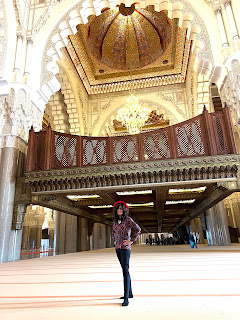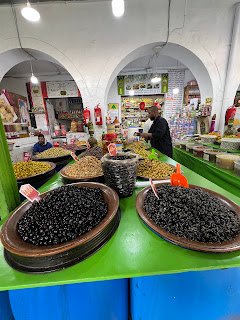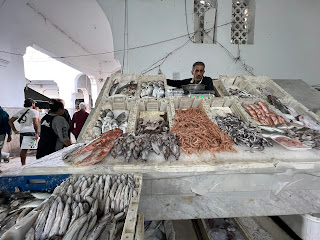Casablanca, Morocco. 12-3-24
Here is the brochure description of today’s tour:
Casablanca is Morocco's largest city and a world-renowned center for trade. Visit the central market, home to hundreds of stalls brimming with locally grown vegetables, meats, seafood, as well as handicrafts. Continue to the new Medina of Casablanca and the Habous quarter with its Arab-Islamic architecture. You'll see the facade of the Royal Palace and cross the quarter and the colorful olive market on foot. Drive through the residential quarter of Anfa and your guide will point out the location of the Casablanca Conference held during World War II. The main highlight of Casablanca is the famous Hassan Il Mosque; stop here for an inside visit of this great architectural masterpiece.
This is the world's largest religious monument after Mecca and its minaret is the tallest. You'll have some free time at United Nations Square for more photo opportunities or even some shopping.
————-—
Morocco stands out among African nations for its rich cultural heritage, diverse landscapes, and unique blend of influences from Africa, Europe, and the Middle East. What sets Morocco apart is its fusion of Berber, Arab, and European elements, creating a tapestry of traditions, languages, and cuisines.
Morocco is one of the few countries in the world where you can ski in the mountains and surf in the ocean on the same day.
One of the most distinctive aspects of Morocco is its geographical diversity, ranging from the rugged Atlas Mountains to the Sahara Desert and the picturesque coastline along the Atlantic Ocean and the Mediterranean Sea. This diversity contributes to Morocco’s allure as a tourist destination and provides a wealth of experiences for visitors.
Morocco’s historical ties with Europe, particularly France and Spain, have influenced its modern identity. French colonial rule left a lasting imprint on Morocco’s administrative systems, language, and architecture, while the country’s Muslim rulers preserved its Islamic heritage and traditions.
The French played a significant role in Morocco’s modernization and urban development, particularly in cities like Casablanca, where European-style boulevards and architecture coexist with traditional Moroccan neighborhoods. Muslim rulers throughout history have also shaped Morocco’s cultural landscape, leaving behind magnificent palaces, mosques, and medinas that reflect the country’s Islamic heritage.
Life in the big city of Casablanca is dynamic and cosmopolitan, with a thriving economy, bustling markets, and a vibrant cultural scene. The city is a melting pot of different cultures and influences, attracting people from all over Morocco and beyond seeking opportunities in business, education, and entertainment.
Aside from the visit to the grand mosque, the rest of today’s tour was quite different from the one I took on the Sky Princess last March.


























































